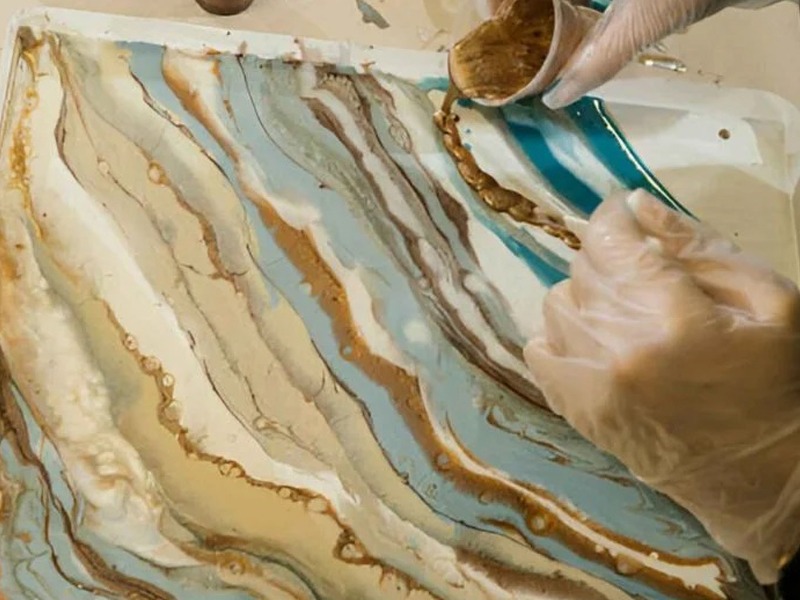1. What Does “Faux Marble” Mean?
Faux marble, also known as artificial marble, cultured marble, or synthetic marble, is a man-made composite material designed to reproduce the natural look of real marble.
It is engineered through advanced chemical processes rather than being quarried from stone, offering aesthetic similarity to genuine marble but with enhanced physical properties and lower production cost.

The term “faux” comes from the French word for “false”, meaning it imitates marble’s luxurious appearance while being made from synthetic materials.
2. What Is Faux Marble Made Of?
Faux marble is typically produced using a resin-based composite system, where various materials are combined to form a durable and decorative surface. The main components include:
- Resin Matrix – The core binding material, usually unsaturated polyester resin (UPR) or vinyl ester resin (VER). This provides strength, flexibility, and chemical resistance.
- Calcium Carbonate (CaCO₃) – A fine filler that gives bulk, texture, and a stone-like appearance.
- Pigments and Color Pastes – Used to mimic the natural veins, tones, and shades found in real marble.
- Curing Agents and Accelerators – Initiate the hardening process, transforming liquid resin into a solid, marble-like material.
- Protective Gel Coat – A glossy surface layer that enhances appearance, waterproofing, and surface durability.
3. How Is Faux Marble Made?
The manufacturing process generally involves several controlled steps:
- Mold Preparation – A mold is coated with a gel coat to form the smooth surface finish.
- Mixing – Resin, fillers, pigments, and catalysts are blended into a uniform mixture.
- Pouring or Spraying – The mixture is poured into the mold to form the desired shape.
- Curing – The material is allowed to harden at controlled temperature and humidity.
- Demolding and Polishing – Once cured, the piece is removed from the mold and polished to achieve a marble-like shine.
This process allows for consistent quality, customizable colors and patterns, and efficient large-scale production.
4. Is Faux Marble Durable?
Yes — faux marble is highly durable when properly manufactured.
Its resin matrix gives it excellent mechanical and chemical properties compared with natural marble.
Key durability advantages include:
✅ Scratch and impact resistance — less likely to crack or chip.
✅ Waterproof and non-porous — prevents mold, staining, or liquid absorption.
✅ Corrosion and chemical resistance — resists acids, alkalis, and cleaning agents.
✅ Heat resistance — suitable for moderate thermal conditions.
✅ UV stability — advanced formulations maintain color over time.
Unlike natural marble, which requires sealing and careful maintenance, faux marble is low-maintenance, easy to clean, and long-lasting.
5. Common Applications of Faux Marble
Due to its combination of aesthetic beauty and technical performance, faux marble is widely used across multiple industries:
- Sanitary Ware – Bathtubs, washbasins, vanity tops, and shower panels.
- Interior Design – Kitchen countertops, tabletops, wall cladding, and decorative panels.
- Commercial Architecture – Hotel lobbies, office receptions, and retail interiors.
- Furniture and Art Design – Sculptures, coffee tables, and display units.
It offers designers the look of natural marble with the flexibility of modern materials.
6. Advantages of Faux Marble Over Natural Marble
| Feature | Natural Marble | Faux Marble |
|---|---|---|
| Source | Quarried stone | Man-made resin composite |
| Cost | High | Moderate to low |
| Porosity | High (requires sealing) | Non-porous |
| Strength | Brittle | Flexible and impact-resistant |
| Maintenance | Regular care needed | Easy to clean |
| Color variety | Limited to nature | Customizable |
| Weight | Heavy | Lighter |
Overall, faux marble offers better practicality, especially for large-scale commercial or modern interior projects.
7. Environmental and Technological Aspects
Recent advancements in resin technology have improved both the sustainability and performance of faux marble materials.
By optimizing resin formulations and filler ratios, manufacturers can:
- Reduce VOC emissions
- Recycle filler materials
- Enhance thermal stability
- Extend product lifespan
These improvements make faux marble not only a cost-effective alternative but also a more environmentally responsible choice compared to natural stone quarrying.
8. Summary
Faux marble represents a modern fusion of chemistry and artistry — combining the beauty of natural marble with the performance benefits of engineered composites.
It is made primarily from resin, fillers, and pigments, resulting in a durable, waterproof, and customizable material that serves diverse applications from sanitary ware to architecture.
So, when people ask “Is faux marble durable?”, the answer is a confident yes — it is built to last, easy to maintain, and adaptable to the creative needs of modern design.
